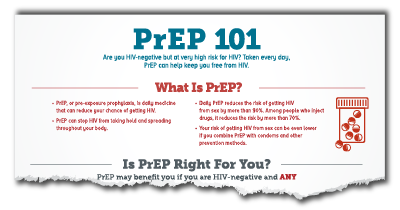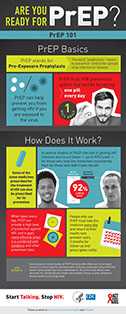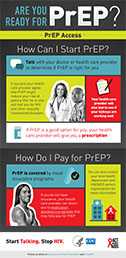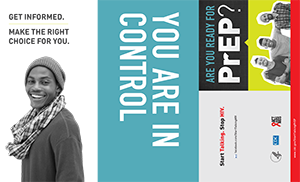PrEP
Pre-exposure prophylaxis (or PrEP) is when people at very high risk for HIV take HIV medicines daily to lower their chances of getting infected. PrEP can stop HIV from taking hold and spreading throughout your body. It is highly effective for preventing HIV if used as prescribed, but it is much less effective when not taken consistently.
Daily PrEP reduces the risk of getting HIV from sex by more than 90%. Among people who inject drugs, it reduces the risk by more than 70%. Your risk of getting HIV from sex can be even lower if you combine PrEP with condoms and other prevention methods.
Video Introductions tp PrEP
What is PrEP? A Brief Intro
Protect yourself. Learn about PrEP (Pre-Exposure Prophylaxis) and how it works in this short video.
PrEP – an HIV Prevention Option
PrEP – an HIV Prevention Option is an animated video that presents basics information on PrEP, how to access and determine if its right for you. The video also promotes communication between gay and bisexual men and their health care providers about PrEP as a prevention option.
What is PrEP?
Pre-exposure prophylaxis (or PrEP) is when people at very high risk for HIV take HIV medicines daily to lower their chances of getting infected. A combination of two HIV medicines (tenofovir and emtricitabine), sold under the name Truvada® (pronounced tru vá duh), is approved for daily use as PrEP to help prevent an HIV-negative person from getting HIV from a sexual or injection-drug-using partner who’s positive. Studies have shown that PrEP is highly effective for preventing HIV if it is used as prescribed. PrEP is much less effective when it is not taken consistently.
Learn more about how to protect yourself and get information tailored to meet your needs from CDC’s HIV Risk Reduction Tool (BETA).
Why take PrEP?
For those at very high risk for HIV, PrEP can significantly reduce your risk of HIV infection if taken daily. Daily PrEP use can lower the risk of getting HIV from sex by more than 90% and from injection drug use by more than 70%. You can combine additional strategies with PrEP to reduce your risk even further.
Learn more about how to protect yourself and get information tailored to meet your needs from CDC’s HIV Risk Reduction Tool (BETA).
Is PrEP a vaccine?
No. PrEP does not work the same way as a vaccine. A vaccine teaches your body to fight off infection for several years. For PrEP, you take a pill every day by mouth. The pill that was shown to be safe and to help block HIV infection is called “Truvada” (pronounced tru vá duh). Truvada is a combination of two drugs (tenofovir and emtricitabine). If you take PrEP daily, the presence of the medicine in your bloodstream can often stop HIV from taking hold and spreading in your body. If you do not take PrEP every day, there may not be enough medicine in your bloodstream to block the virus.
Learn more about how to protect yourself and get information tailored to meet your needs from CDC’s HIV Risk Reduction Tool (BETA).
Should I consider taking PrEP?
PrEP is for people without HIV who are at very high risk for getting it from sex or injection drug use. The federal guidelines recommend that PrEP be considered for people who are HIV-negative and in an ongoing sexual relationship with an HIV-positive partner.
This recommendation also includes anyone who
- isn’t in a mutually monogamous* relationship with a partner who recently tested HIV-negative, and
- is a . . .
- gay or bisexual man who has had anal sex without using a condom or been diagnosed with an STD in the past 6 months, or
- heterosexual man or woman who does not regularly use condoms during sex with partners of unknown HIV status who are at substantial risk of HIV infection (for example, people who inject drugs or women who have bisexual male partners).
PrEP is also recommended for people who have injected drugs in the past 6 months and have shared needles or works or been in drug treatment in the past 6 months.
If you have a partner who is HIV-positive and are considering getting pregnant, talk to your doctor about PrEP if you’re not already taking it. PrEP may be an option to help protect you and your baby from getting HIV infection while you try to get pregnant, during pregnancy, or while breastfeeding.
Because PrEP involves daily medication and regular visits to a health care provider, it may not be right for everyone. And PrEP may cause side effects like nausea in some people, but these generally subside over time. These side effects aren’t life threatening. See Is PrEP safe?
* Mutually monogamous means that you and your partner only have sex with each other and do not have sex outside the relationship.
Learn more about how to protect yourself and get information tailored to meet your needs from CDC’s HIV Risk Reduction Tool (BETA).
How well does PrEP work?
Studies have shown that PrEP reduces the risk of getting HIV from sex by more than 90% when used consistently. Among people who inject drugs, PrEP reduces the risk of getting HIV by more than 70% when used consistently.
See our website for links to these studies.
Learn more about how to protect yourself and get information tailored to meet your needs from CDC’s HIV Risk Reduction Tool (BETA).
Is PrEP safe?
PrEP can cause side effects like nausea in some people, but these generally subside over time. No serious side effects have been observed, and these side effects aren’t life threatening. If you are taking PrEP, tell your health care provider about any side effects that are severe or do not go away.
Learn more about how to protect yourself and get information tailored to meet your needs from CDC’s HIV Risk Reduction Tool (BETA).
How can I start PrEP?
PrEP can be prescribed only by a health care provider, so talk to yours to find out if PrEP is the right HIV prevention strategy for you. You must take PrEP daily for it to work. Also, you must take an HIV test before beginning PrEP to be sure you don’t already have HIV and every 3 months while you’re taking it, so you’ll have to visit your health care provider for regular follow-ups.
The cost of PrEP is covered by many health insurance plans, and a commercial medication assistance program provides free PrEP to people with limited income and no insurance to cover PrEP care.
Learn more about how to protect yourself and get information tailored to meet your needs from CDC’s HIV Risk Reduction Tool (BETA).
How do I speak to my doctor or other health care provider about PrEP?
Please see the brochure Talk to Your Doctor About PrEP in English and Spanish, which has some questions you should ask your health care provider when discussing whether PrEP (taking daily HIV medicines) is right for you.
Learn more about how to protect yourself and get information tailored to meet your needs from CDC’s HIV Risk Reduction Tool (BETA).
How can I get help to pay for PrEP?
The cost of PrEP is covered by many health insurance plans, and a commercial medication assistance program provides free PrEP to people with limited income and no insurance to cover PrEP care.
Learn more about how to protect yourself and get information tailored to meet your needs from CDC’s HIV Risk Reduction Tool (BETA).
If I take PrEP, can I stop using condoms when I have sex?
No, you should not stop using condoms because you are taking PrEP. PrEP doesn’t give you any protection against other STDs, like gonorrhea and chlamydia. Also, while PrEP can significantly reduce your risk of HIV infection if taken daily, you can combine additional strategies like condom use with PrEP to reduce your risk even further.
If used the right way every time you have sex, condoms are highly effective in preventing HIV and some STDs you can get through body fluids, like gonorrhea and chlamydia. However, they provide less protection against STDs spread through skin-to-skin contact, like human papillomavirus or HPV (genital warts), genital herpes, and syphilis. See How well do condoms prevent HIV? Learn the right way to use a male condom.
Learn more about how to protect yourself and get information tailored to meet your needs from CDC’s HIV Risk Reduction Tool (BETA).
How long do I need to take PrEP?
You must take PrEP daily for it to work. But there are several reasons people stop taking PrEP. For example,
- If your risk of getting HIV infection becomes low because of changes in your life, you may want to stop taking PrEP.
- If you find you don’t want to take a pill every day or often forget to take your pills, other ways of protecting yourself from HIV infection may work better for you.
- If you have side effects from the medicine that are interfering with your life, or if blood tests show that your body is reacting to PrEP in unsafe ways, your provider may stop prescribing PrEP for you.
You should discuss this question with your health care provider.
Learn more about how to protect yourself and get information tailored to meet your needs from CDC’s HIV Risk Reduction Tool (BETA).
How long do I have to take PrEP before it is effective?
When taken every day, PrEP is safe and highly effective in preventing HIV infection. PrEP reaches maximum protection from HIV for receptive anal sex at about 7 days of daily use. For receptive vaginal sex and injection drug use, PrEP reaches maximum protection at about 20 days of daily use. No data are yet available about how long it takes to reach maximum protection for insertive anal or insertive vaginal sex.
Learn more about how to protect yourself and get information tailored to meet your needs from CDC’s HIV Risk Reduction Tool (BETA).
Does taking PrEP long-term have harmful health effects?
In people who are HIV-negative and have taken PrEP for up to 5 years, no significant health effects have been seen.
Learn more about how to protect yourself and get information tailored to meet your needs from CDC’s HIV Risk Reduction Tool (BETA).
Can you start PrEP after you have been exposed to HIV?
PrEP (pre-exposure prophylaxis) is only for people who are at ongoing very high risk of HIV infection. But PEP (post-exposure prophylaxis) is an option for someone who thinks they’ve recently been exposed to HIV during sex or through sharing needles and works to prepare drugs.
PEP means taking antiretroviral medicines after a potential exposure to HIV to prevent becoming infected. PEP must be started within 72 hours of possible exposure to HIV. If you’re prescribed PEP, you’ll need to take it once or twice daily for 28 days. See our PEP Q&As for more information.
Learn more about how to protect yourself and get information tailored to meet your needs from CDC’s HIV Risk Reduction Tool (BETA).
Where can I find resources about PrEP?
Visit the CDC PrEP resources page for infographics, videos, fact sheets, reports, and other educational materials about PrEP, including resources for health care providers.
Learn more about how to protect yourself and get information tailored to meet your needs from CDC’s HIV Risk Reduction Tool (BETA).
Infographics
Click on the images below to view and download high resolution infographics dedicated to PrEP (Pre-Exposure Prophylaxis), an HIV prevention option that works by taking one pill every day. Are you ready for PrEP? These graphics present complex information quickly and clearly and may help answer some of your questions.
Content provided and maintained by the US Centers for Disease Control and Prevention (CDC). Please see our system usage guidelines and disclaimer.
- Page last reviewed: October 12, 2017
- Page last updated: October 12, 2017
- Content source:


 ShareCompartir
ShareCompartir




